Review of rounds 1–3 of the Asian Cities Team Championship by IM Vladimir Barsky
The Asian Cities Team Championship is a long-awaited international tournament in Russia from the official FIDE calendar! It would probably be an exaggeration to say that “all the flags shall visit us,” but the capital city of Ugra saw the arrival of many interesting and combative teams, not all of which are even from Asia. There are experienced grandmasters, young stars, talented kids, even a woman-only team from Tehran… There are lots of intense and sparkling games: many things to see, many examples to show. Let’s begin with an episode of “The Obvious and the Improbable”.
Liyanage Ranindu Dilshan (2343) – Aleksei Pridorozhni (2509)
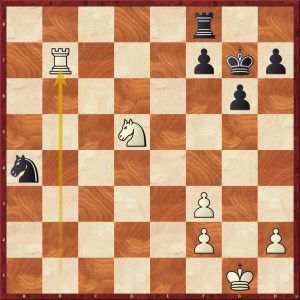
You may wonder how Black could win such a position at all. But nothing is impossible for the Russian rapid chess champion!
28…Nc5 29.Ra7
After 29.Rb5 Ne6 30.f4 Rd8, White’s main task is to avoid blundering a piece: 31.Kg2?? Rxd5 32.Rxd5 Nxf4+. To that end, 31.h3 is enough, to get the king through h2 to g3.
29…Rd8 30.Nf4
Or 30.Ne3. It’s hard to comment on anything here. For some reason, White decided to give up a pawn to force a knight trade and go for a 3 pawn vs. 2 pawn rook endgame, which is, of course, completely safe too.
30…Rd4 31.Rc7 Rxf4 32.Rxc5 Rxf3 33.Kg2 Rd3 34.Rc7 g5 35.h3 Kg6 36.Rc6+ f6 37.Ra6 h6 38.Rb6 Rd4 39.Ra6 h5 40.Ra8 g4 41.hxg4 Rxg4+ 42.Kh3
It was simpler to keep the king on f3. Even without the f2 pawn, many positions here are drawn.
42…Kg5 43.Rg8+ Kf4 44.Rh8 Rg5 45.Rh6 f5 46.Kh4 Rg2
Aleksei continues to search for chances, and his opponent finally makes a mistake.
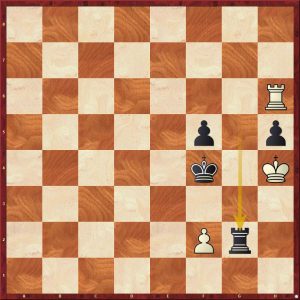
47.Kxh5?
White could maintain the balance with 47.Kh3 Rxf2 48.Rxh5 Ke4 49.Rh6 f4 50.Ra6.
47…Rxf2 48.Ra6 Kg3?
This natural move, however, misses the win. Black had to push the king away first: 48…Rh2+! 49.Kg6 Kg4 winning.
49.Kg5?
White spoils his lucky chance. He could save the game with 49.Ra3+! Rf3 (49…Kg2 50.Rb3 f4 51.Kg4 gives nothing) 50.Ra5! f4 (or 50…Kg2 51.Ra2+ Kg3 52.Ra5) 51.Rg5+! Kf2 52.Kg4, and it’s time to agree for a draw.
49…f4 50.Kf5 Rb2 51.Ke4 Re2+ 52.Kd3 f3 53.Rg6+ Kf2 54.Rf6 Re8 55.Ra6 Kg2 56.Kd4 White resigned.
Nikolai Kabanov (2434) – K K Dinujaya Kodithuwakku Kankana (1707)
1.e4 e5 2.Nf3 Nc6 3.Bb5 Nge7 4.0-0 Ng6 5.d4 exd4 6.Nxd4 Bc5 7.Nf5 0–0 8.Nc3 a6 9.Ba4 d6 10.Qh5 b5 11.Bb3 Na5
Black played the opening rather recklessly, leaving his king largely undefended. But White’s advance party is already at the gates…
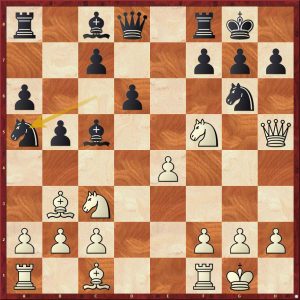
12.Bg5 Qe8 13.Nxg7! Qe5
After 13…Kxg7 14.Qh6+ Kg8 15.Bf6, there’s no defence from checkmate on g7.
14.Nd5 Bd4 15.c3
Not the only way to win, but it’s the clearest one.
15…Qxg7 16.cxd4 Nxb3
After 16…f6 17.Bh6, Black has to retreat with his queen 17…Qh8 to avoid losing it, but then the king gets in trouble – 18.Ne7#.
17.Bf6 Nxa1 18.Bxg7 Kxg7 19.Rxa1 Ra7 20.Rc1 Bd7 21.e5 dxe5 22.dxe5 Be6 23.Nf6 h6 24.Qd1

White has both material (queen and pawn vs. rook and bishop) and positional advantage. Nikolai Kabanov easily won the game.
Abtin Atakhan (2417) – Yuan Hui Yeoh (1894)
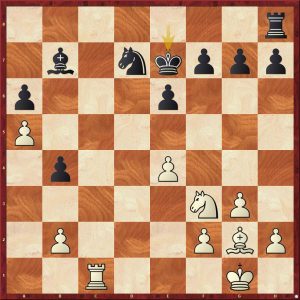
25.Rc7
Looks like a decisive invasion: the bishop is hanging, the knight is pinned. However, the safety margin in chess is usually quite big…
25…Rb8?
Black should have gone for a dangerous-looking king walk: 25…Bxe4 26.Ne5 Kd6 (but not 26…Bxg2? 27.Rxd7+ Kf6 28.f4 Bd5 29.Rxf7#) 27.Rxd7+ Kxe5. Strangely enough, the king is safe here: 28.f4+ Kf5 29.Rxf7+ Kg6 30.Ra7 Bxg2 31.Kxg2 Rd8!, and after, for instance, 32.Rxa6 Rd2+ 33.Kf3 Rxb2 34.Rxe6+ Kf7 35.Rb6 Ra2 36.a6 b3, there’s a drawn rook ending with 3 vs. 2 pawns on the same flank.
26.Ne5 Bc8
Now 26…Kd6 is bad in view of 27.Rxd7+ Kxe5 28.f4+ Kf6 29.e5+ Kg6 30.Rxb7.
27.Nc6+ Kd6 28.Rxd7+ Kxd7 29.Nxb8+ Kc7 30.Nxa6+ Bxa6 31.e5!
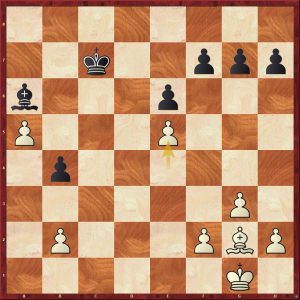
Black trapped the knight and only lost a pawn as a result. However, this bishop ending, unlike the rook ending above, is completely hopeless for him. He has to watch out for the a5 passer, and the e6 and f7 pawns are fixed on the squares of the same color as the bishop.
31…Kb8 32.f4
This is also good, but 32.Bc6 Bd3 33.f4 Ka7 34.Be8 Bg6 35.Bb5 is apparently even more precise.
32…Ka7 33.Kf2 Bb5 34.Ke3 Ka6 35.Kd4 Kxa5 36.Kc5 Bd3 37.Bc6 Bf5 38.Be8 Bg6 39.g4 h5
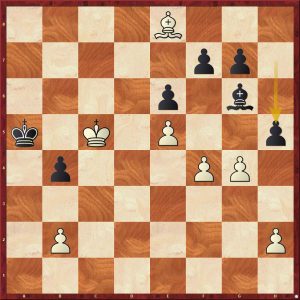
40.gxh5
The break 40.f5! exf5 41.gxf5 Bxf5 42.Bxf7 finished the game rather elegantly.
40…Bxh5 41.Kd6 Bg6 42.Ke7 Bf5 43.Bxf7 Ka4 44.Bxe6 Bxe6 45.Kxe6 Kb3 46.Kf7 Kxb2 47.e6 Kc3 48.e7 Black resigned.
Maxim Novikov (2435) – Salim Al Amri Salim Mohammed (1938)
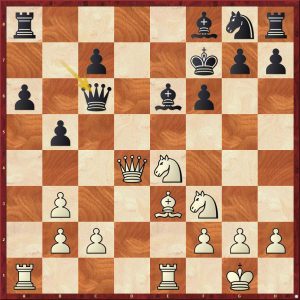
“In the Wake of Opening Catastrophes,” as Yakov Isaevich Neishtadt’s book was called:
16.Neg5+ Kg6
16…fxg5 is met with the fork 17.Ne5+, and 16…Ke7 with the pin 17.Bd2. Still, after the game move, the king also has nowhere to go.
17.Qd3+ Bf5 18.Nh4+ Kh5 19.Qxf5 Nh6 20.g4+ Nxg4 21.Ne4+ g5 22.Bxg5 Black resigned.
Amjad Wazwaz – Dmitry Kirillov (2209)

White is completely outplayed, but, as they say, “As long as I live, I hope!”
33…b4 34.Rxb3 cxb3 35.Rxc6 b2 36.Rxg6+!?
The famous “spite check”?
36…fxg6??
Wow, this worked! After a simple king retreat (say, 36…Kf8), White should resign.
37.Bd5+! Kg7 38.Bxa2 Kf6 39.g4 h5 40.h3 h4 41.Ke4, and now it’s Black who resigns.
Zozek Salah Mohammed Mohammed (2171) – Stefan Palamar (1813)
There was a dynamic balance in a tense, double-edged position for a long time, but then Black apparently overestimated his attacking chances.
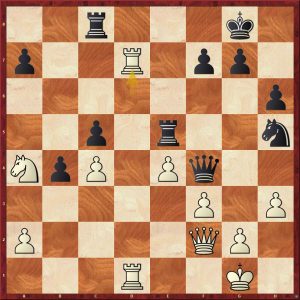
29…Rc6?!
Stronger was 29…Rg5 30.g4 (30.Rxa7? loses to 30…Qb8! 31.Rdd7 Nf4) 30…Nf6 31.R7d3 Qc7 with a very sharp play.
30.Nb2!
The knight, which stood idly on the edge of the board for quite a while, begins its winning march.
30…Rg5 31.Nd3 Qf6 32.f4?!
A return mistake. After 32.Kh2! Nf4 33.Nxf4 Qxf4+ 34.g3, Black has to retreat, and his position became quite worrisome.
32…Rg3 33.Rd5 Qc3?
33…Qh4! 34.Kf1 Rf6 maintained the balance.
34.Ne5! Rf6 35.f5 Qe3 36.Rd8+ Kh7

37.Nd7!
Reminds of the famous match game of the two great K’s! The soulless computer insists that the prosaic 37.Qxe3 Rxe3 38.Re8 g6 39.Rdd8 Rb6 40.Ng4 was even stronger, but this move was good as well: Black immediately resigned.
Akar Ali Salih Salih (2205) – Aleksandr Machankin (1739)
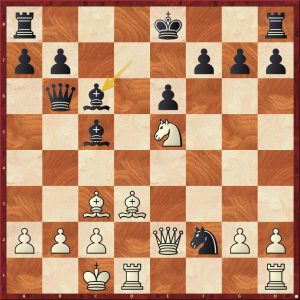
“It’s not my fault if you didn’t hide!”
14.Nxf7! Be3+
14…Kxf7 is even sadder: 15.Qh5+ Kf8 (or 15…g6 16.Qe5 Rhf8 17.Bc4) 16.Qe5 Rg8 17.Bc4 with an unstoppable attack.
15.Kb1 Kxf7
The unexpected 15…0–0! is more resilient, even though after 16.Ne5 Qc5 (16…Nxh1 17.Qh5 loses quickly) 17.Bc4 Nxh1 18.b4! Qb6 19.Qg4, White’s threats are still dangerous.
16.Qh5+ Ke7 (16…g6 17.Qe5) 17.Qe5 Rag8 18.Bc4 Bd7

At the first glance it might seem that White’s attack fizzled out. He’s a knight down, and his rooks are forked… but then a dagger-sharp blow comes from the left!
19.Ba5! Qc6
There was an elegant economic mate after 19…Qc5 20.Rxd7+! Kxd7 21.Qxe6#.
20.Qxe3 Nxd1
Black is a whole rook up, but all the squares around his king are hopelessly weak.
21.Qg5+ Ke8 22.Bb4 Black resigned.
Ilia Iljiushenok (2536) – Stanislav Khudyakov (2230)
Let’s talk a bit more about the f7 square, which is often called the Achilles’ heel of Black’s position. White pieces are looming dangerous over the black king’s position, and so Khudyakov’s desire to drive one of them away is totally understandable.
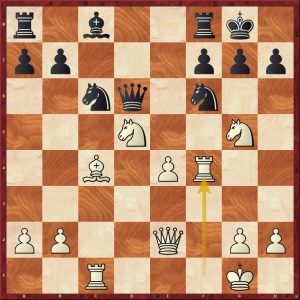
17…h6
Now a standard, but still pretty tactical blow is possible. Still, even after 17…Nxd5, the f7 square would have still been a target, but for a different combination: 18.Rxf7! Rxf7 19.Bxd5 Ne5 20.Nxf7 Nxf7 21.Qc4, winning.
Black apparently could still resist after 17…b5!?, but, to be honest, it’s hard to believe in that.
18.Nxf7! Rxf7 19.Nxf6+ Kh8
19…gxf6 would have been met with 20.Bxf7+ Kxf7 21.Qh5+ Kg7 22.Rf3! Ne5 23.Rg3+ Kh7 24.Rxc8! Rxc8 25.Qf5+ etc.
20.e5!
With this beautiful interference, White defends the f4 rook and (as we shall see a couple of moves later) gives his queen access to the h5 square.
20…Qc5+
The pawn cannot be taken because this loses the f7 rook – either immediately or after a queen trade.
21.Kh1 gxf6
White cannot capture the rook because of a pin, but the position of the black king is in ruins…

22.Qh5! (the interference along the 5th rank works!) 22…Be6 23.Qxh6+ Kg8 24.Rg4+ Black resigned.
Marat Gilfanov (2080) – Nikolai Kabanov (2434)
Experienced grandmaster Kabanov, probably underestimating his young opponent, relaxed a bit and exposed himself for a tactical blow with his last move 48…Kg7-h6.

49.g5+! Kxg5
The rest is even worse: 49…fxg5 50.Rxf8; 49…Kh7 50.Rxf6 Rxf6 51.gxf6 gxh5 52.Bxh5; 49…Kg7 50.h6+ Kh7 51.Kg3.
50.Rg3+ Kf4
After 50…Kh6 51.Rxg6+ Kh7 52.Kf3, the white king goes for a walk on the light squares.
51.hxg6 Kxe4 52.g7 Rg8 53.Bc4 Rbb8 54.Rxd6 f5
Hoping to satisfy White with an exchange sacrifice. But White has a much more interesting target now.
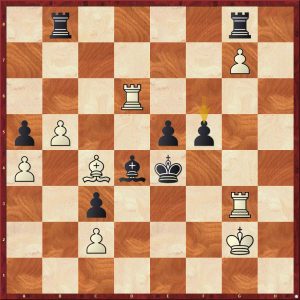
55.Bd3+ Kf4 56.Rf3+ Kg5 57.Rxf5+ Kh4 58.Rh6+ Black resigned in view of 58…Kg4 59.Rhh5! и 60.Be2#.
Bardiya Daneshvar (2584) – Ilia Iljiushenok (2536)
One of the most interesting games of the first third of the Cities Championship was played in the key match of the 3rdround, Tehran – Surgut.
1.Nf3 Nf6 2.g3 c5 3.Bg2 Nc6 4.c4 d5 5.cxd5 Nxd5 6.Nc3 g6 7.h4 h6 8.d3 Bg7 9.Nxd5 Qxd5 10.Be3 Bxb2
This capture, of course, looks very risky. On the other hand, after 10…0–0 11.Qd2, White is somewhat better.
11.0–0 Qd6
Perhaps Black had to go all-in – 11…Bxa1 12.Qxa1 f6. Of course, Black’s position after, for instance, 13.Nd4 Qd7 14.Nxc6 bxc6 15.Rc1 Kf7 16.Rxc5, doesn’t look too attractive, but he has the extra exchange as a consolation.
12.Rb1 Bd4 13.Bf4 Qf6

14.Qc1
14.e3 Bc3 15.Qb3 also looks quite attractive, for example: 15…Bb4 16.a3 Ba5 (16…Be6 17.Qa4) 17.Rfc1 with a very unpleasant pressure from White.
14…g5 15.hxg5 hxg5 16.Bxg5 Qg6 17.e3 Qh5

18.Bh4
The bishop is, of course, cannot be captured: after 18.exd4? Nxd4, Black wins. However, the young Iranian grandmaster overlooked a beautiful tactical blow 18.Bxe7!! What should Black now do?
1) After 18…Nxe7, White now can play 19.exd4, and the counterplay comes too late: 19…Bh3 (19…cxd4 20.Re1 Kf8 21.Qa3 is even worse) 20.Qxc5 Bxg2 21.Qxh5 Rxh5 22.Kxg2.
2) After 18…Bg4, there’s a very strong reply 19.Nh4! Kxe7 20.Rxb7+ Kf8, and here White has a pleasant choice between 21.exd4 Nxd4 22.Re1 and the simple 21.Bxc6.
3) The only remaining move is 18…Kxe7, but here, after 19.exd4 Nxd4, White has a very important intermediate check 20.Re1+!, which gives his king an escape square at f1: 20…Kf8 21.Nxd4 cxd4 22.Re4 Qh2+ 23.Kf1 Bh3!? 24.Qc5+ Kg8 25.Qg5+ Kf8 26.Bxh3 Qxh3+ 27.Ke2 Qh5+ (Black has to trade queens, because 27…b6 is met with a flashy mating attack: 28.Rh1! Qxh1 29.Qe7+ Kg7 30.Rg4+ Kh6 31.Qg5+ Kh7 32.Qg7#) 28.Qxh5 Rxh5 29.Rxb7 with a decisive advantage in the rook endgame.
18…Bf6 19.Bxf6 exf6 20.d4?!
20.Nh4 Ne5 21.Qb2 gave more chances for an advantage..
20…cxd4 21.exd4 Bh3 22.Re1+ Kf8 23.Qc5+ Qxc5 24.dxc5 Bxg2 25.Kxg2 Rb8 26.Nd2 Rh5 27.Ne4 Kg7

28.Rec1
The worst is over for Black. After 28.f4!?, White could have still played on for a bit, but Daneshvar seemed to be content with a draw at this point.
28…Rbh8 29.Kf3 Rf5+ 30.Kg2 Rfh5 31.Kf3 Rf5+ 32.Kg2 Draw.
Ivan Bocharov (2559) – Sina Movahed (2463)
Another thriller from the same key encounter. White sacrificed a knight for a pawn, but the black king is stuck in the center and exposed from all sides.
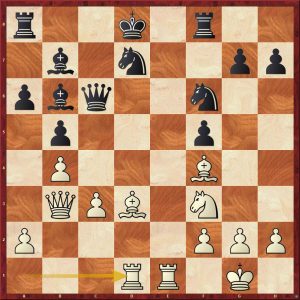
22…Nd5?
The position is not yet ripe for a counter-attack. After the careful 22…Bc7! 23.Bg3 (23.Bg5 h6) 23…Bxg3 24.hxg3 Re8, Black had all chances to gradually repel the attack and retain the extra material.
23.Ne5
Even stronger was 23.Bg5+! Kc8 (23…N5f6 24.Bxf5) 24.c4! bxc4 25.Bxc4 with very dangerous threats.
23…Nxe5
After 23…Bxf2+! 24.Kxf2 Qb6+ 25.Re3 Nxe5 26.Be2 Nd7 27.Rxd5 Bxd5 28.Qxd5 Rc8 29.Kf1 Qc6, Black is close to equality.
24.Rxe5 Kc8 25.Bxf5+ Rxf5 26.Rxf5 Nf6
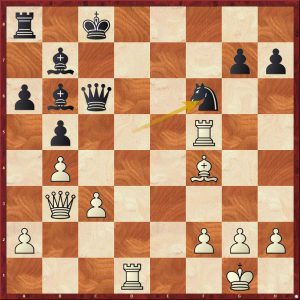
27.Qg8+!
Pretty! Thankfully for Black, he’s not obliged to capture the queen (27…Nxg8 28.Rf8+ with an unavoidable mate).
27…Ne8 28.Rg5
Stronger was 28.Rfd5!, closing off the long diagonal. After 28…Qg6 29.Re1 Bxd5 30.Rxe8+ Kd7 31.Qxd5+ Kxe8 32.Qxa8+, White should win.
28…Qe4 29.Rxg7
And here, 29.Be5! was very promising, for instance: 29…Bc6 30.Qe6+ Kb7 31.Rxg7+ Bc7 (31…Nxg7 32.Rd7+ Bxd7 33.Qxd7+ leads to mate) 32.Qe7 Qe2 33.Rc1 – Black aren’t likely to hold this.
29…Bd5 30.Re7 Bxf2+! 31.Kh1 Bxg8 32.Rxe4 Kb7 33.Re7+ Kc6 34.a3
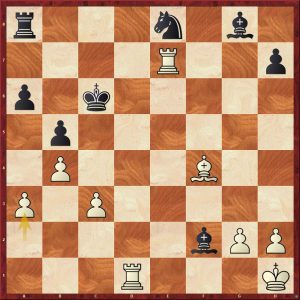
Complications have ended, and Black managed to survive until the endgame. Still, White’s chances are still better; after 50 moves, Ivan Bocharov managed to win after all.
Ali Ehsan Aryan (2136) – Kristina Kim (1941)
Another f7 square-themed game concludes our review.
1.e4 g6 2.d4 Bg7 3.Nc3 d6 4.f4 Nf6 5.Nf3 Nc6 6.d5 Nb8 7.e5 dxe5?
This move seems to be losing more or less by force. 7…Nfd7 was necessary, even though Black’s position would still be peculiar, to put it mildly.
8.fxe5 Ng4 9.Bf4 g5
To eliminate the e5 pawn. Otherwise, the g4 knight would have had to escape to the edge of the board quite soon (after h2-h3 and possibly g2-g4).
10.Nxg5 Nxe5 11.Bxe5 Bxe5
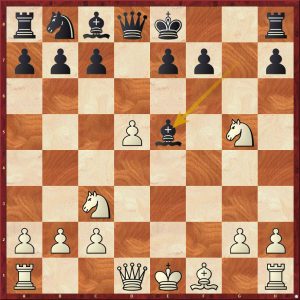
12.Nxf7! Bxc3+
After the immediate 12…Kxf7, the e5 bishop is lost – 13.Qh5+ Kf6 14.Ne4+ Kg7 15.Qxe5+.
13.bxc3 Kxf7 14.Qh5+ Kg7 15.Qg5+ Kf8 16.Bb5!
To stop the opponent from involving the knight in defence.
16…Nd7 17.Bxd7
Of course not 17.0–0+ Nf6.
17…Qxd7
The king can now escape to d8. But Black loses a rook on the way.

18.0–0+!
You don’t get to castle with a check every day!
18…Ke8 19.Qg7 Qg4 20.Qxh8+ Kd7 21.Rae1 Qg5 22.Re5 Qg6 23.Rfe1 Kd6 24.Qd8+ Black resigned.
